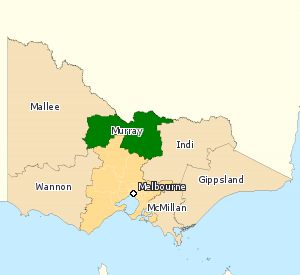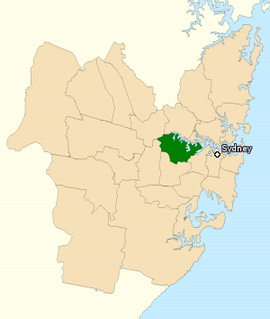
The Division of Corangamite is an Australian electoral division in the state of Victoria. The division was proclaimed in 1900, and was one of the original 65 divisions to be contested at the first federal election. It is named for Lake Corangamite, although the lake no longer falls within the division's boundaries.

The Division of Charlton was an Australian electoral division in the state of New South Wales. The division was created in 1984 and is named for Matthew Charlton, who was Leader of the Australian Labor Party 1922–28.

The Division of Hindmarsh is an Australian Electoral Division in South Australia covering the western suburbs of Adelaide. The division was one of the seven established when the former Division of South Australia was split on 2 October 1903, and was first contested at the 1903 election, though on vastly different boundaries. The Division is named after Sir John Hindmarsh, who was Governor of South Australia from 1836 to 1838. The 78 km² seat extends from the coast in the west to South Road in the east, covering the suburbs of Ascot Park, Brooklyn Park, Edwardstown, Fulham, Glenelg, Grange, Henley Beach, Kidman Park, Kurralta Park, Morphettville, Plympton, Richmond, Semaphore Park, Torrensville, West Beach and West Lakes. The international Adelaide Airport is centrally located in the electorate making noise pollution a prominent local issue, besides the aged care needs of the relatively elderly population − the seat has one of the highest proportions of citizens over the age of 65 in Australia. Progressive boundary redistributions over many decades transformed Hindmarsh from a safe Labor seat in to a marginal seat often won by the government of the day.
The Division of Darling was an Australian electoral division in the state of New South Wales. The division was proclaimed in 1900, and was one of the original 65 divisions to be contested at the first federal election. From 1901 until 1922 it was based on Bourke, Cobar, Nyngan, Coonamble and Gilgandra. From 1906, it also included Dubbo. The 1922 redistribution increased the number of voters in some rural electorates and as a result the division of Barrier was abolished with most of its population, including the large mining town of Broken Hill, Wentworth and Balranald, was absorbed by Darling along with Hay from Riverina. Dubbo was transferred to Gwydir in 1922 but returned to Darling in 1934. In 1948, Dubbo, Gilgandra and Coonamble were transferred to the new division of Lawson and Hay and Balranald were transferred to Riverina. In 1955 Coonamble returned to Darling. In 1977 it was abolished with Broken Hill and Wentworth going to Riverina and Bourke, Cobar, Nyngan and Coonamble going to Gwydir.

The Division of Fremantle is an electoral division of the Australian House of Representatives in Western Australia.

The Division of Macquarie is an Australian electoral division in the state of New South Wales. The division was created in 1900 and was one of the original 65 divisions contested at the first federal election. It is named for Lachlan Macquarie, who was Governor of New South Wales between 1810 and 1821.

The Division of Throsby was an Australian electoral division in the state of New South Wales. The division was named after Charles Throsby, a prominent pioneer and explorer in the early nineteenth century of the areas to the south of Sydney.

The Division of Hunter is an Australian electoral division in the state of New South Wales. The division was proclaimed in 1900, and was one of the original 65 divisions to be contested at the first federal election. The division was named after Captain John Hunter, the second Governor of New South Wales. It covers rural, regional and suburban areas centred on the Hunter Region, including the towns of Singleton, Muswellbrook and Cessnock. It also extends into parts of Greater Newcastle, covering suburbs such as Cameron Park, Edgeworth, Toronto and Morisset.

The Division of Riverina is an Australian electoral division in the state of New South Wales.

The Division of Richmond is an Australian electoral division in the state of New South Wales.

The Division of Kalgoorlie was an Australian Electoral Division in the state of Western Australia, named after the city of Kalgoorlie. The Division was proclaimed in 1900 as one of the original 75 divisions to be contested at the first Federal election. In its final form, it covered most of the land area of Western Australia, with a size of 2,295,354 square kilometres (886,241 sq mi)—over 90 percent of the state's landmass. It included the Goldfields-Esperance, Gascoyne, Pilbara and Kimberley regions of Western Australia, in addition to the eastern and far northern parts of the Mid West region, and the town of Merredin. It was the largest single-member electorate by area in the world—almost a third of the continent.

The Division of New England is an Australian electoral division in the state of New South Wales.

The Division of Parkes is an Australian electoral division in the state of New South Wales.

The Division of Murray was an Australian Electoral Division in the state of Victoria. It was located in the north of the state, adjoining the Murray River, which forms Victoria's border with New South Wales. It included the towns of Shepparton, Echuca, Cobram, Yarrawonga, Boort and Bridgewater. In 2018 the division was renamed the Division of Nicholls, coming into effect at the 2019 federal election.

The Division of Paterson is an Australian electoral division in the state of New South Wales. It is located just north of Newcastle, on the coast of the Tasman Sea. The division is named after federation-era poet and author Banjo Paterson and was originally created in 1949 and abolished in 1984. It was recreated after a redistribution in 1992.

The Division of Reid is an Australian electoral division in the state of New South Wales.

The Division of Shortland is an Australian electoral division in the state of New South Wales.
In Australia, a redistribution is the process of redrawing the boundaries of electoral divisions for the House of Representatives arising from changes in population and changes in the number of representatives. There is no redistribution for the Senate as each State constitutes a division, though with multiple members. The Australian Electoral Commission (AEC), an independent statutory authority, oversees the apportionment and redistribution process for federal divisions, taking into account a number of factors. Politicians, political parties and the public may make submissions to the AEC on proposed new boundaries, but any interference with their deliberations is considered a serious offence.

The 2010 Australian federal election was held on Saturday, 21 August 2010 to elect members of the 43rd Parliament of Australia. The incumbent centre-left Australian Labor Party led by Prime Minister Julia Gillard won a second term against the opposition centre-right Liberal Party of Australia led by Opposition Leader Tony Abbott and Coalition partner the National Party of Australia, led by Warren Truss, after Labor formed a minority government with the support of three independent MPs and one Australian Greens MP.

New South Wales politics takes place in context of bicameral parliamentary system. The main parties are the Liberal and National parties of the governing Coalition and the Australian Labor Party. Other minor political parties include the Greens, Shooters, Fishers and Farmers Party, the Christian Democratic Party, the One Nation, the Liberal Democratic Party and the Keep Sydney Open..




























